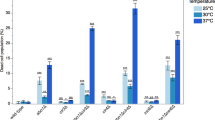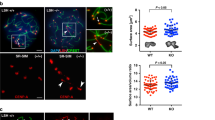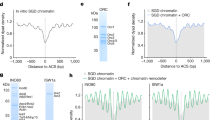Abstract
The heterochromatin protein 1 (HP1)-rich heterochromatin domains next to centromeres are crucial for chromosome segregation during mitosis. This mitotic function requires their faithful reproduction during the preceding S phase, a process whose mechanism and regulation are current puzzles. Here we show that p150, a subunit of chromatin assembly factor 1, has a key role in the replication of pericentric heterochromatin and S-phase progression in mouse cells, independently of its known function in histone deposition. By a combination of depletion and complementation assays in vivo, we link this unique function of p150 to its ability to interact with HP1. Absence of this functional interaction triggers S-phase arrest at the time of replication of pericentromeric heterochromatin, without eliciting known DNA-based checkpoint pathways. Notably, in cells lacking the histone methylases Suv39h, in which pericentric domains do not show HP1 accumulation, p150 is dispensable for S-phase progression.
This is a preview of subscription content, access via your institution
Access options
Subscribe to this journal
Receive 12 print issues and online access
$189.00 per year
only $15.75 per issue
Buy this article
- Purchase on Springer Link
- Instant access to full article PDF
Prices may be subject to local taxes which are calculated during checkout





Similar content being viewed by others
References
Luger, K., Mader, A.W., Richmond, R.K., Sargent, D.F. & Richmond, T.J. Crystal structure of the nucleosome core particle at 2.8 Å resolution. Nature 389, 251–260 (1997).
Grewal, S.I. & Jia, S. Heterochromatin revisited. Nat. Rev. Genet. 8, 35–46 (2007).
Peng, J.C. & Karpen, G.H. Epigenetic regulation of heterochromatic DNA stability. Curr. Opin. Genet. Dev. 18, 204–211 (2008).
Gilbert, N. et al. Formation of facultative heterochromatin in the absence of HP1. EMBO J. 22, 5540–5550 (2003).
Maison, C. & Almouzni, G. HP1 and the dynamics of heterochromatin maintenance. Nat. Rev. Mol. Cell Biol. 5, 296–304 (2004).
Kalitsis, P. & Choo, K.H.A. Centromere DNA of higher eukaryotes. in The Centromere (ed. Choo, K.H.A.) 97–140 (Oxford Univ. Press, New York, 1997).
Guenatri, M., Bailly, D., Maison, C. & Almouzni, G. Mouse centric and pericentric satellite repeats form distinct functional heterochromatin. J. Cell Biol. 166, 493–505 (2004).
Kaufman, P.D., Kobayashi, R., Kessler, N. & Stillman, B. The p150 and p60 subunits of chromatin assembly factor I: a molecular link between newly synthesized histones and DNA replication. Cell 81, 1105–1114 (1995).
Polo, S.E. & Almouzni, G. Chromatin assembly: a basic recipe with various flavours. Curr. Opin. Genet. Dev. 16, 104–111 (2006).
Groth, A., Rocha, W., Verreault, A. & Almouzni, G. Chromatin challenges during DNA replication and repair. Cell 128, 721–733 (2007).
Cheutin, T. et al. Maintenance of stable heterochromatin domains by dynamic HP1 binding. Science 299, 721–725 (2003).
Festenstein, R. et al. Modulation of heterochromatin protein 1 dynamics in primary mammalian cells. Science 299, 719–721 (2003).
Karpen, G.H. & Allshire, R.C. The case for epigenetic effects on centromere identity and function. Trends Genet. 13, 489–496 (1997).
Folco, H.D., Pidoux, A.L., Urano, T. & Allshire, R.C. Heterochromatin and RNAi are required to establish CENP-A chromatin at centromeres. Science 319, 94–97 (2008).
Verreault, A., Kaufman, P.D., Kobayashi, R. & Stillman, B. Nucleosome assembly by a complex of CAF-1 and acetylated histones H3/H4. Cell 87, 95–104 (1996).
Smith, S. & Stillman, B. Purification and characterization of CAF-I, a human cell factor required for chromatin assembly during DNA replication in vitro. Cell 58, 15–25 (1989).
Krude, T. Chromatin assembly factor 1 (CAF-1) colocalizes with replication foci in HeLa cell nuclei. Exp. Cell Res. 220, 304–311 (1995).
Taddei, A., Roche, D., Sibarita, J.B., Turner, B.M. & Almouzni, G. Duplication and maintenance of heterochromatin domains. J. Cell Biol. 147, 1153–1166 (1999).
Shibahara, K. & Stillman, B. Replication-dependent marking of DNA by PCNA facilitates CAF-1-coupled inheritance of chromatin. Cell 96, 575–585 (1999).
Moggs, J.G. et al. A CAF-1/PCNA mediated chromatin assembly pathway triggered by sensing DNA damage. Mol. Cell. Biol. 20, 1206–1218 (2000).
Murzina, N., Verreault, A., Laue, E. & Stillman, B. Heterochromatin dynamics in mouse cells: interaction between chromatin assembly factor 1 and HP1 proteins. Mol. Cell 4, 529–540 (1999).
Thiru, A. et al. Structural basis of HP1/PXVXL motif peptide interactions and HP1 localisation to heterochromatin. EMBO J. 23, 489–499 (2004).
Quivy, J.P. et al. A CAF-1 dependent pool of HP1 during heterochromatin duplication. EMBO J. 23, 3516–3526 (2004).
Tagami, H., Ray-Gallet, D., Almouzni, G. & Nakatani, Y. Histone H3.1 and H3.3 complexes mediate nucleosome assembly pathways dependent or independent of DNA synthesis. Cell 116, 51–61 (2004).
Ye, X. et al. Defective S phase chromatin assembly causes DNA damage, activation of the S phase checkpoint, and S phase arrest. Mol. Cell 11, 341–351 (2003).
Hoek, M. & Stillman, B. Chromatin assembly factor 1 is essential and couples chromatin assembly to DNA replication in vivo. Proc. Natl. Acad. Sci. USA 100, 12183–12188 (2003).
Takami, Y., Ono, T., Fukagawa, T., Shibahara, K. & Nakayama, T. Essential role of chromatin assembly factor-1-mediated rapid nucleosome assembly for DNA replication and cell division in vertebrate cells. Mol. Biol. Cell 18, 129–141 (2007).
Polo, S.E., Roche, D. & Almouzni, G. New histone incorporation marks sites of UV repair in human cells. Cell 127, 481–493 (2006).
Dimitrova, D.S. & Berezney, R. The spatio-temporal organization of DNA replication sites is identical in primary, immortalized and transformed mammalian cells. J. Cell Sci. 115, 4037–4051 (2002).
Nabatiyan, A. & Krude, T. Silencing of chromatin assembly factor 1 in human cells leads to cell death and loss of chromatin assembly during DNA synthesis. Mol. Cell. Biol. 24, 2853–2862 (2004).
Tibbetts, R.S. et al. A role for ATR in the DNA damage-induced phosphorylation of p53. Genes Dev. 13, 152–157 (1999).
Paull, T.T. et al. A critical role for histone H2AX in recruitment of repair factors to nuclear foci after DNA damage. Curr. Biol. 10, 886–895 (2000).
Bartek, J. & Lukas, J. DNA damage checkpoints: from initiation to recovery or adaptation. Curr. Opin. Cell Biol. 19, 238–245 (2007).
Azuara, V. et al. Heritable gene silencing in lymphocytes delays chromatid resolution without affecting the timing of DNA replication. Nat. Cell Biol. 5, 668–674 (2003).
Reese, B.E., Bachman, K.E., Baylin, S.B. & Rountree, M.R. The methyl-CpG binding protein MBD1 interacts with the p150 subunit of chromatin assembly factor 1. Mol. Cell. Biol. 23, 3226–3236 (2003).
Sarraf, S.A. & Stancheva, I. Methyl-CpG binding protein MBD1 couples histone H3 methylation at lysine 9 by SETDB1 to DNA replication and chromatin assembly. Mol. Cell 15, 595–605 (2004).
Peters, A.H. et al. Loss of the Suv39h histone methyltransferases impairs mammalian heterochromatin and genome stability. Cell 107, 323–337 (2001).
Maison, C. et al. Higher-order structure in pericentric heterochromatin involves a distinct pattern of histone modification and an RNA component. Nat. Genet. 30, 329–334 (2002).
Maga, G., Stucki, M., Spadari, S. & Hubscher, U. DNA polymerase switching: I. Replication factor C displaces DNA polymerase α prior to PCNA loading. J. Mol. Biol. 295, 791–801 (2000).
Houlard, M. et al. CAF-1 is essential for heterochromatin organization in pluripotent embryonic cells. PLoS Genet. 2, e181 (2006).
Kaya, H. et al. FASCIATA genes for chromatin assembly factor-1 in Arabidopsis maintain the cellular organization of apical meristems. Cell 104, 131–142 (2001).
Schonrock, N., Exner, V., Probst, A., Gruissem, W. & Hennig, L. Functional genomic analysis of CAF-1 mutants in Arabidopsis thaliana. J. Biol. Chem. 281, 9560–9568 (2006).
Kirik, A., Pecinka, A., Wendeler, E. & Reiss, B. The chromatin assembly factor subunit FASCIATA1 is involved in homologous recombination in plants. Plant Cell 18, 2431–2442 (2006).
Quivy, J.P., Grandi, P. & Almouzni, G. Dimerization of the largest subunit of chromatin assembly factor 1: importance in vitro and during Xenopus early development. EMBO J. 20, 2015–2027 (2001).
Kaufman, P.D., Kobayashi, R. & Stillman, B. Ultraviolet radiation sensitivity and reduction of telomeric silencing in Saccharomyces cerevisiae cells lacking chromatin assembly factor I. Genes Dev. 11, 345–357 (1997).
Enomoto, S., McCune-Zierath, P., Geraminejad, M., Sanders, M. & Berman, J. Rlf2, a subunit of yeast chromatin assembly factor-I, is required for telomeric chromatin function in vivo. Genes Dev. 11, 358–363 (1997).
Kats, E.S., Albuquerque, C.P., Zhou, H. & Kolodner, R.D. Checkpoint functions are required for normal S-phase progression in Saccharomyces cerevisiae RCAF- and CAF-I-defective mutants. Proc. Natl. Acad. Sci. USA 103, 3710–3715 (2006).
Tercero, J.A., Longhese, M.P. & Diffley, J.F. A central role for DNA replication forks in checkpoint activation and response. Mol. Cell 11, 1323–1336 (2003).
Lambert, S., Watson, A., Sheedy, D.M., Martin, B. & Carr, A.M. Gross chromosomal rearrangements and elevated recombination at an inducible site-specific replication fork barrier. Cell 121, 689–702 (2005).
Ahn, J.S., Osman, F. & Whitby, M.C. Replication fork blockage by RTS1 at an ectopic site promotes recombination in fission yeast. EMBO J. 24, 2011–2023 (2005).
Byun, T.S., Pacek, M., Yee, M.C., Walter, J.C. & Cimprich, K.A. Functional uncoupling of MCM helicase and DNA polymerase activities activates the ATR-dependent checkpoint. Genes Dev. 19, 1040–1052 (2005).
Zou, L. & Elledge, S.J. Sensing DNA damage through ATRIP recognition of RPA-ssDNA complexes. Science 300, 1542–1548 (2003).
Bartek, J., Lukas, C. & Lukas, J. Checking on DNA damage in S phase. Nat. Rev. Mol. Cell Biol. 5, 792–804 (2004).
Ben-Yehoyada, M., Gautier, J. & Dupre, A. The DNA damage response during an unperturbed S-phase. DNA Repair (Amst) 6, 914–922 (2007).
Groth, A. et al. Regulation of replication fork progression through histone supply and demand. Science 318, 1928–1931 (2007).
Ye, X. & Adams, P.D. Coordination of S-phase events and genome stability. Cell Cycle 2, 185–187 (2003).
Poot, R.A. et al. The Williams syndrome transcription factor interacts with PCNA to target chromatin remodelling by ISWI to replication foci. Nat. Cell Biol. 6, 1236–1244 (2004).
Acknowledgements
We thank J. Haber for critical reading of the manuscript and members of our unit for discussions (D. Ray-Gallet, S. Polo, M.K. Ray and J. Chow); S. Huart for quantitative co-localization analyses; N. Murzina (Department of Biochemistry, University of Cambridge) and A. Verreault (IRIC, Université de Montréal, Canada) for the gift of mouse GFPp150 constructs; M. Moné for establishing 3T3Flp cell lines stably expressing GFPp150 proteins (Institute of Molecular Cell Biology, Faculty for Earth and Life Sciences, Vrije Universiteit, Amsterdam). A.G. received support from Délégation Générale pour l'Armement (DGA/DSP/STTC/DT/SH) and Association pour la Recherche sur la Cancer. A.J.L.C. received support from la Ligue Nationale Contre le Cancer. This work was supported by la Ligue Nationale Contre le Cancer (Equipe labellisée la Ligue), the Institut Curie PIC Programs ('Retinoblastome' and 'Replication, Instabilité chromosomique et cancer'), the European Commission Network of Excellence Epigenome (LSHG-CT-2004-503433), ACI-2004-Cancéropole IdF 'Breast cancer and epigenetics, ANR 'CenRNA' NT05-4_42267 and ANR 'FaRC', PCV06_142302.
Author information
Authors and Affiliations
Contributions
J.-P.Q. and G.A. conceived and designed the experiments; J.-P.Q., A.G., A.J.L.C. and D.R. performed the experiments; J.-P.Q., A.G., A.J.L.C., D.R. and G.A. analyzed the data; J.-P.Q., A.J.L.C. and G.A. wrote the paper.
Corresponding author
Supplementary information
Supplementary Text and Figures
Supplementary Figures 1–5 and Supplementary Methods (PDF 12287 kb)
Rights and permissions
About this article
Cite this article
Quivy, JP., Gérard, A., Cook, A. et al. The HP1–p150/CAF-1 interaction is required for pericentric heterochromatin replication and S-phase progression in mouse cells. Nat Struct Mol Biol 15, 972–979 (2008). https://doi.org/10.1038/nsmb.1470
Received:
Accepted:
Published:
Issue Date:
DOI: https://doi.org/10.1038/nsmb.1470
This article is cited by
-
Parental nucleosome segregation and the inheritance of cellular identity
Nature Reviews Genetics (2021)
-
Nuclear actin filaments in DNA repair dynamics
Nature Cell Biology (2019)
-
HP1 cooperates with CAF-1 to compact heterochromatic transgene repeats in mammalian cells
Scientific Reports (2018)
-
Histone chaperone networks shaping chromatin function
Nature Reviews Molecular Cell Biology (2017)
-
Grabbing the genome by the NADs
Chromosoma (2016)



